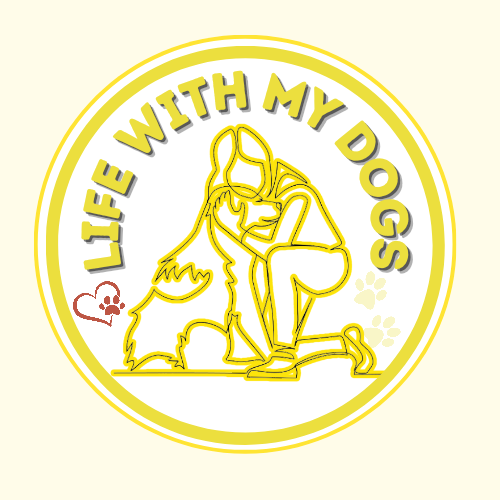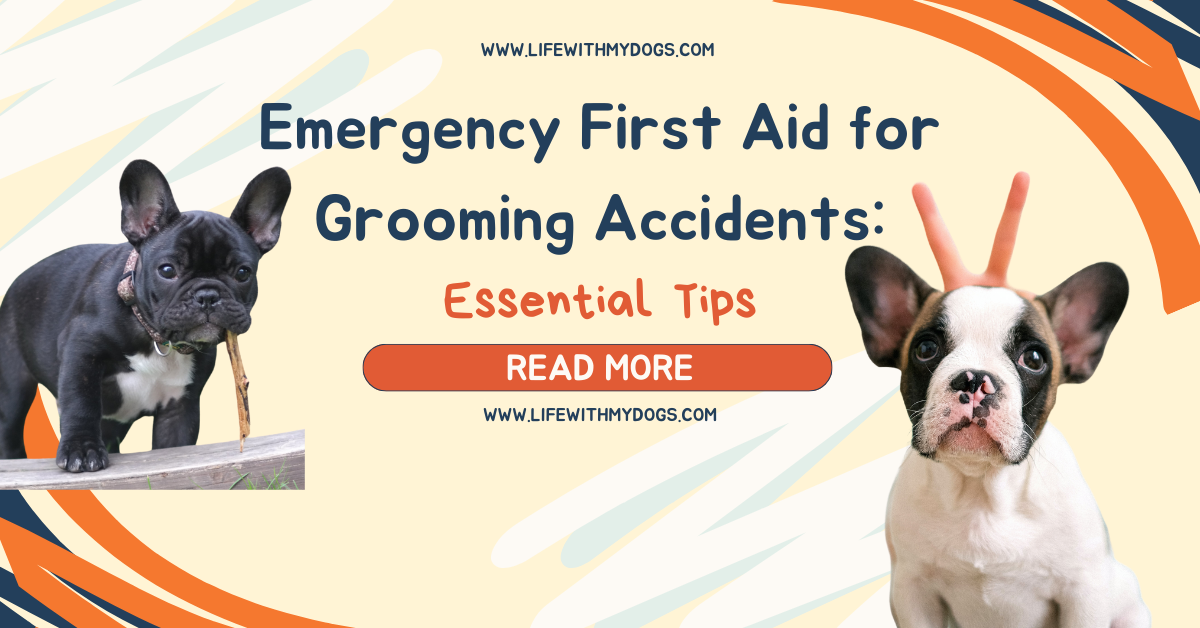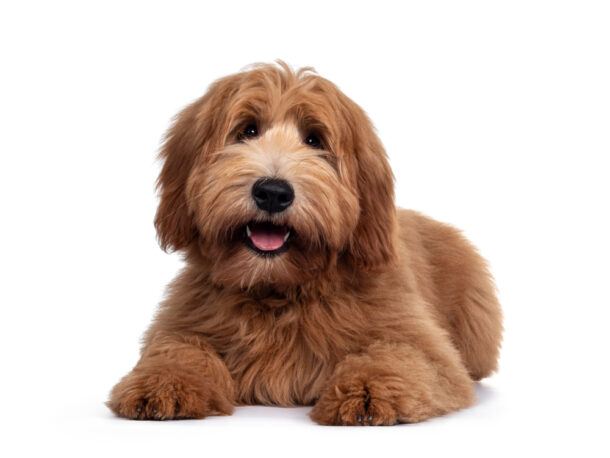LifeWithMyDogs is supported by our audience. When you purchase through one of our links, we may earn a small affiliate commission. As an Amazon Associate I earn from qualifying purchases. Your cost is not affected.
**********
As dog owners, it’s crucial to understand the risks involved in grooming and handling pets. While grooming accidents can occur, being equipped with the right knowledge of emergency first aid can significantly mitigate the situation.
It’s not uncommon for pets to sustain cuts, scratches, or other injuries during grooming. Therefore, knowing how to respond effectively to these incidents is essential for their health and well-being.
Emergency First Aid for Grooming Accidents: Essential Tips for Dog Owners

Emergency first aid for grooming accidents encompasses a range of responses, from treating minor cuts and lacerations to addressing more severe conditions such as burns, scalds, or even poisonings. Although many situations will still require professional veterinary care, initial first aid can prevent further harm to your pet and may even save their lives. Familiarizing yourself with basic first aid measures can, indeed, prepare you for the unexpected and ensure you are taking the best possible care of your furry family member.
Key Takeaways
- Understanding grooming risks is crucial for your pet’s safety.
- Essential first-aid knowledge can mitigate grooming accidents.
- Immediate care can prevent further harm when professional help is sought.
Recognizing Common Grooming Hazards

In the realm of dog grooming, being aware of potential hazards is critical to preventing accidents. Here’s what you should look out for.
Sharp Tools and Equipment Risks
Scissors, clippers, and trimmers are, of course, essential in grooming, but they can cause cuts or punctures if misused. For example, dull tools can lead to pulling hair and unnecessary discomfort. In order to avoid these, always handle these tools with care and ensure they are kept sharp.
Chemical Product Safety
Be cautious of shampoos, conditioners, and flea treatments that contain chemicals. These can cause allergic reactions or burns if not used according to the manufacturer’s instructions. Always perform a patch test or consult your vet before trying a new product.
Electrical Device Dangers
Electrical devices like dryers and electric nail grinders pose risks of burns or shock if they malfunction or are used improperly. Never leave your dog unattended with an electrical device running, and regularly check for frayed cords or damaged equipment.
Preventing Grooming Accidents

Accidents during grooming can often be avoided through proper preparation and care. Ensuring you have the right techniques, tools, and environment can make all the difference.
Proper Handling Techniques
To minimize the risk of injuries, consistent, gentle restraint is crucial. When you hold a dog, support both their hips and chest.
Use a grooming table with a non-slip surface and a secure grooming loop that includes a quick-release feature for rapid disconnection in case of emergency. Keep your movements calm and deliberate to prevent startling the pet.
Choosing the Right Grooming Tools
Selecting appropriate tools for the task at hand is essential. For instance, use rounded-tip scissors to trim areas near the eyes and ears safely.
Brushes and combs should be the right type for your dog’s coat to prevent pulling and discomfort. Haemostatic powder is a valuable addition to your toolkit to quickly stop bleeding if a nail is accidentally cut too short.
Establishing a Safe Grooming Environment
Create a calm and secure location for grooming. Ensure the area is free of hazards like exposed wires or slippery surfaces.
Keep your grooming tools organized and within reach to prevent any unnecessary movement that could startle the dog. Maintaining clean equipment is also vital to prevent infection; consider having disinfectant wipes on hand for quick sanitation.
First Aid Basics

In emergency grooming accidents, swift and accurate response is crucial. You should quickly assess the situation, have emergency contact information ready, and maintain a well-stocked first aid kit.
Assessing the Situation
Before you attempt any first aid, evaluate the scene for safety. Ensure that you’re not putting yourself at risk while trying to help your dog.
Then, calmly assess your dog’s condition. Look for obvious signs of injury or distress, such as bleeding, limping, or abnormal behavior.
Emergency Contact Information
Have your veterinarian’s phone number easily accessible. It’s best to keep it on your phone and posted somewhere visible near your grooming area. Additionally, know the location of the nearest 24-hour emergency veterinary clinic and how to reach them.
First Aid Kit Essentials
Your grooming first aid kit should include the following essentials:
- Gauze pads and roll gauze for wrapping wounds
- Non-stick bandages or strips to cover injuries
- Adhesive tape for securing bandages (never use it directly on fur)
- Scissors with blunt ends to cut bandages without causing injury
- Tweezers to remove debris like splinters from a paw
- Disposable gloves to maintain hygiene and protect yourself
- Saline solution to clean wounds or flush eyes
- Antibiotic ointment to prevent infection
Remember to check your kit regularly and replace any used or outdated items.
Responding to Cuts and Lacerations

When your dog suffers a cut or laceration, prompt and effective action is essential to prevent further injury and infection. Your response should include immediate actions to control bleeding, thorough wound cleaning, and appropriate bandaging.
Immediate Actions
Your first step is to calmly and safely restrain your pet to prevent further injury. Then, assess the severity of the cut to determine if veterinary care is needed.
For minor wounds, gently apply pressure with a clean cloth to stop bleeding. Always wear gloves to protect both yourself and your pet from infection.
Wound Cleaning and Bandaging
After bleeding is under control, clean the wound with a saline solution or mild antiseptic. Avoid using hydrogen peroxide or alcohol, as these can damage tissue and delay healing.
Cover the wound with sterile, non-stick gauze to absorb moisture and protect it from dirt. Secure the gauze with a cohesive bandage that sticks to itself but not to fur.
Monitoring for Infection
Inspect the wound daily for signs of infection, such as redness, swelling, or discharge. If you notice any of these symptoms or if the wound does not heal properly, consult your veterinarian immediately. Keep your dog from licking or scratching the wound by using an Elizabethan collar if necessary.
Handling Burns and Scalds

When your dog suffers a burn or scald during grooming, prompt and appropriate first aid is crucial to minimize damage and pain. Here’s how to manage the situation effectively.
Initial Burn First Aid
- Cool the Burn: Immediately remove your dog from the heat source. Run cool (not cold) water over the affected area for at least 5 minutes or until the pain eases. This helps reduce swelling and pain.
- Assess the Burn: Determine the burn’s severity. If the skin is just red and painful, it’s likely a minor burn. However, seek emergency care if you notice blisters, swelling, white or charred skin.
Ongoing Burn Care
- Protect the Burn: After cooling, gently pat the area dry and cover it with a sterile, non-fluffy dressing or cloth to protect against infection.
- Monitor for Shock: Keep your dog calm and quiet. If the burn is more than superficial or covers a large area, your dog may be at risk of shock. Observe for signs like weakness, rapid heart rate, and lethargy.
Preventing Scarring and Infection
- Aid Healing: Apply a thin layer of veterinary-approved antibiotic ointment if the skin isn’t broken.
- Avoid Irritation: Do not apply ice, as this can cause further damage. Also, avoid using cotton wool or other materials that might stick to the burn.
Remember, serious burns require professional veterinary treatment to avoid complications such as scarring and infection. It’s important to follow up with ongoing proper care at home.
Treating Sprains and Fractures

When your dog suffers a grooming accident, recognizing the signs of sprains and fractures and knowing how to respond can be crucial for their well-being. Proper immobilization of the affected limb and timely veterinary care are vital steps.
Identifying Sprains and Fractures
Sprains in dogs often occur when ligaments are stretched beyond their normal range. Symptoms include lameness, swelling, and discomfort.
Fractures, however, involve a broken bone and can lead to more obvious signs, such as an abnormal angle or shape of the limb, swelling, and the inability to bear weight. Immediate pain and vocalization from your dog could be strong indications of a fracture.
Immobilization Techniques
If you suspect a sprain or fracture, it’s important to immobilize the limb with care to prevent further injury.
For sprains:
-
- Restrain your dog from moving too much.
- Apply cold compresses to the affected area to reduce swelling.
For fractures:
-
- Stabilize the limb using a homemade splint, like a magazine or a towel wrapped around the limb, only if you must move your dog before veterinary care can be provided.
- Avoid manipulation of the broken limb to prevent pain and additional damage.
When to Seek Veterinary Care
Always seek immediate veterinary care if a fracture is suspected. For minor sprains, if there’s no improvement within 48 hours or symptoms worsen, contact your veterinarian.
Here is additional information on first aid for sprains and fractures to review. Remember, when in doubt, professional evaluation is the safest choice to ensure your dog’s health and recovery.
Dealing with Eye and Ear Injuries

When your dog suffers an eye or ear injury during grooming, prompt and appropriate action is crucial. The following steps will guide you through the first response and treatment, helping you prevent further harm and monitor for any complications.
Eye Injury First Response
If your dog suffers an eye injury, your immediate goal is to avoid further irritation or damage. Calmly secure your dog and gently flush the eye with a sterile eyewash to remove any debris or irritants. Carefully prevent your dog from pawing at its eye, which could exacerbate the injury.
Ear Injury Treatment
For ear injuries, minimizing movement and preventing your dog from shaking its head is important. If the ear is bleeding, carefully bandage the ear against the head to provide some stability and seek veterinary care within 24 hours. Clean minor cuts with a gentle antiseptic and, if needed, apply a suitable antibacterial cream while you arrange for a professional assessment.
Monitoring for Complications
Observe your dog closely after any eye or ear injury for signs of infection or behavioral changes. Look for discharge, odor, or changes in balance or hearing. Any of these could indicate a complication requiring veterinary attention. Record your observations to provide clear information to your vet.
Choking and Asphyxiation Response
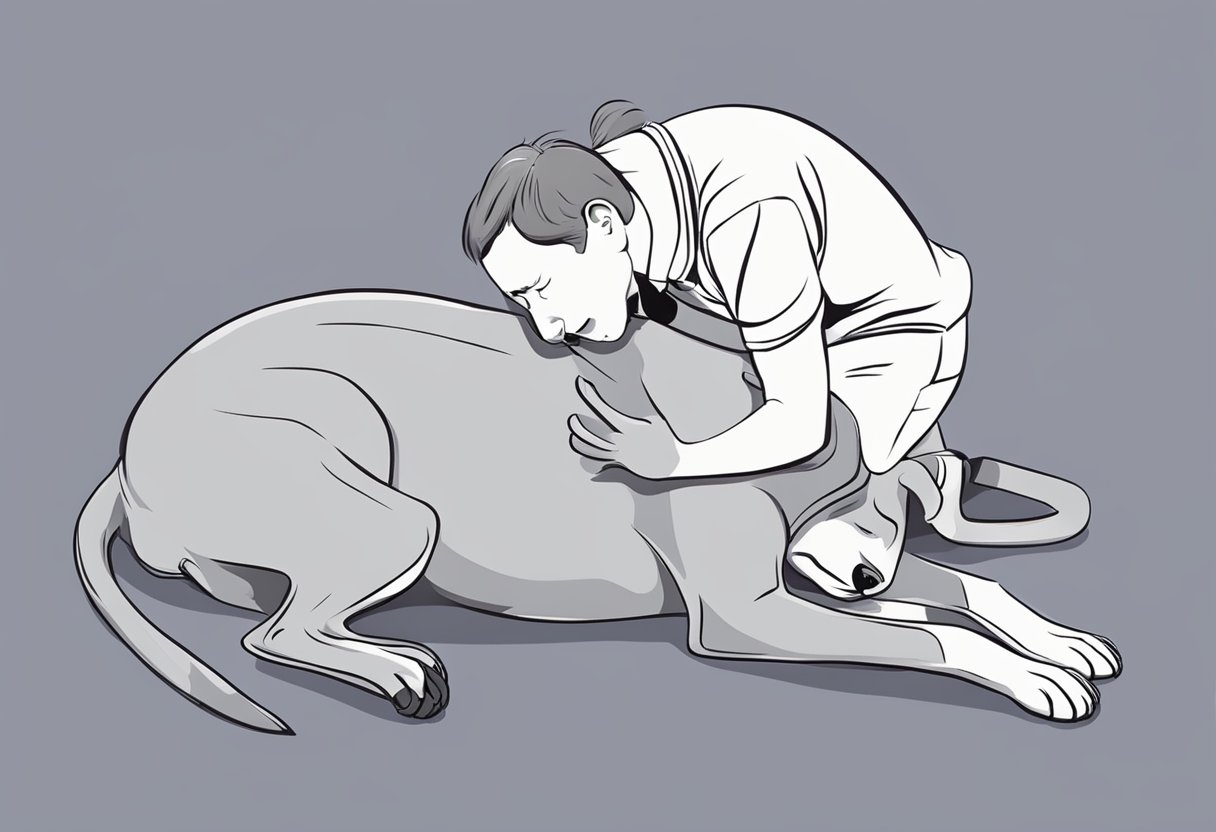
If your dog is choking, rapid and appropriate action can be the difference between life and death. Understand the signs of choking, know how to clear the airway, and be prepared to perform CPR if necessary.
Recognizing Choking Signs
- Quickened or distressed breathing: Watch for unusual effort in inhaling or exhaling.
- Pawing at the mouth or face: Indicates discomfort or an attempt to remove an obstruction.
- Panicked behavior: This may include running erratically or violently struggling.
- Blue-tinged or pale gums: A sign of oxygen deprivation.
Clearing the Airway
- Open your dog’s mouth to inspect for visible obstructions.
- Careful handling: Use the technique of folding the lips over the teeth to avoid being bitten.
- Remove any obstructions that you can see safely.
- Gentle approach: Use a pair of tweezers for small objects.
If the object is not visible or too far to reach, or if the removal attempt is not successful, you may need to perform an emergency procedure to expel the object from the airway.
CPR for Dogs
CPR for dogs involves both chest compressions and rescue breathing.
- Check for breathing and a pulse.
- Begin chest compressions:
- Position: Lay your dog on its side.
- Compression Location: Over the widest part of the rib cage, not over the heart.
- Technique: Keep your arms straight while applying pressure.
- Rescue Breathing:
- Close your dog’s mouth and extend the neck to open the airway.
- Cover the nose with your mouth and blow gently, watching for the chest to rise.
In case of a choking emergency, the American Kennel Club provides detailed instructions on how to perform the Heimlich Maneuver for Dogs, which can be a crucial skill to dislodge the object from your dog’s throat. If you are unable to clear the airway, seek veterinary assistance immediately.
Managing Poisoning and Toxic Exposure
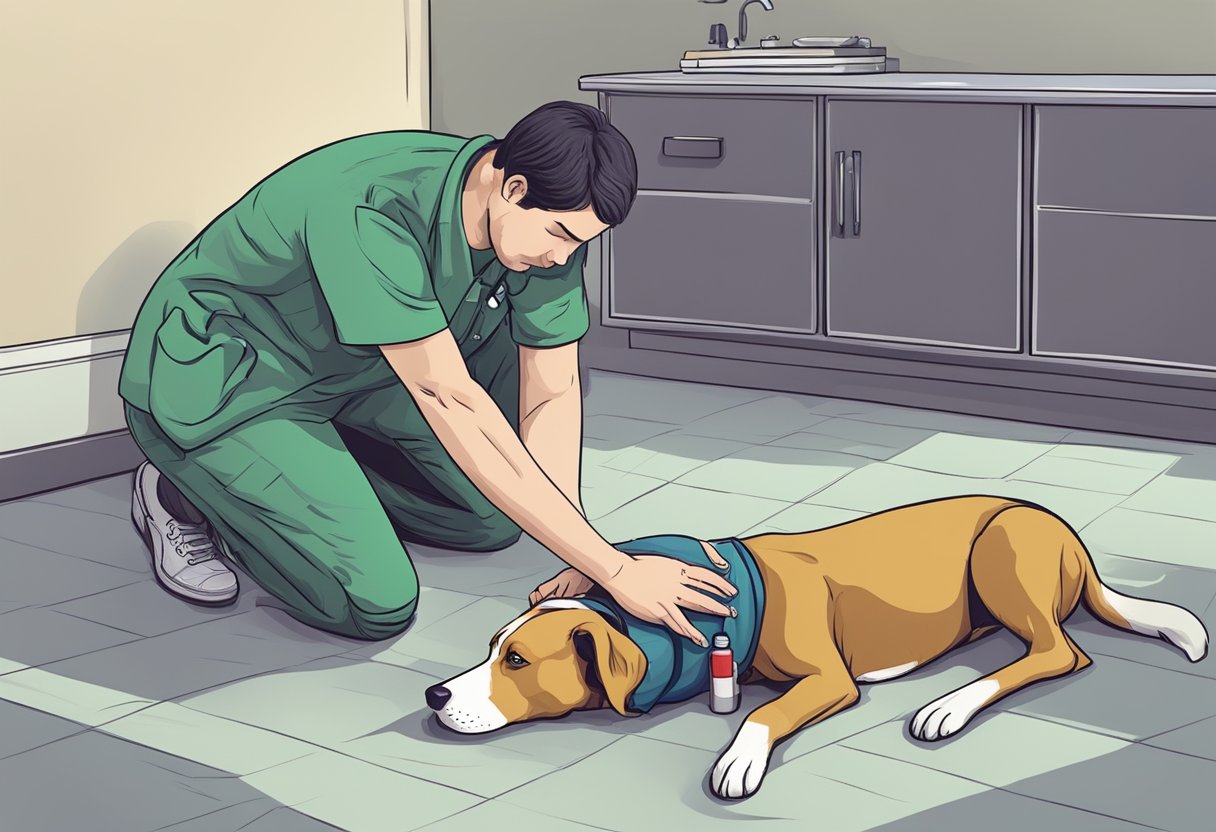
When your dog encounters a poisonous substance, quick and appropriate action is crucial. Knowing what to do can, in fact, save your dog’s life.
Identifying Poisonous Substances
Common Toxic Substances:
- Human medications, for example, ibuprofen, acetaminophen
- Foods like chocolate, xylitol (often found in sugar-free gum), grapes
- Plants such as lilies, azaleas, tulips
- Household chemicals, for instance, cleaners, antifreeze, rodent poisons
If you suspect your dog has ingested or come in contact with a dangerous substance, look for symptoms such as vomiting, diarrhea, excessive salivation, or difficulty breathing.
Immediate Detoxification Procedures
If ingestion just occurred:
- Do not induce vomiting unless instructed by a professional.
- If you have the product label, read the first-aid advice provided.
For immediate assistance, contact Poison Control online or by calling 800-222-1222.
If topical exposure:
- Gently rinse your dog’s skin or coat it with lukewarm water and mild dish soap.
- Avoid scrubbing the skin too harshly.
Follow-up Care and Observation
After initial emergency procedures:
- Monitor your pet closely for any changes or escalation in symptoms.
- Keep a log of symptoms and any treatments given to inform the vet.
- Follow your veterinarian’s instructions for continued detoxification and care.
Remember, regular vet check-ups and keeping harmful substances out of reach are indeed the best ways to prevent poisoning incidents.
Documentation and Follow-Up

Adequate documentation and follow-up are crucial steps in managing grooming accidents. These actions ensure proper care for the injured pet and support preventative measures for the future.
Recording the Incident
Immediately after any incident, record the details; use a log or a digital form to document:
- Time and date of the accident
- Description of the incident
- First aid measures taken
- Names of individuals involved, including witnesses
- Photos of the injury, if possible
Maintaining accurate records helps understand how the injury occurred and is critical if veterinary follow-up is needed.
Post-Incident Evaluation
Once the immediate aftermath is addressed, evaluate the situation. Ask yourself:
- Were first aid measures effective?
- How did the pet respond?
- Is a veterinary check-up necessary?
Schedule a follow-up with a professional if there’s any concern about the pet’s well-being. Ensuring the pet has recovered fully from any trauma experienced.
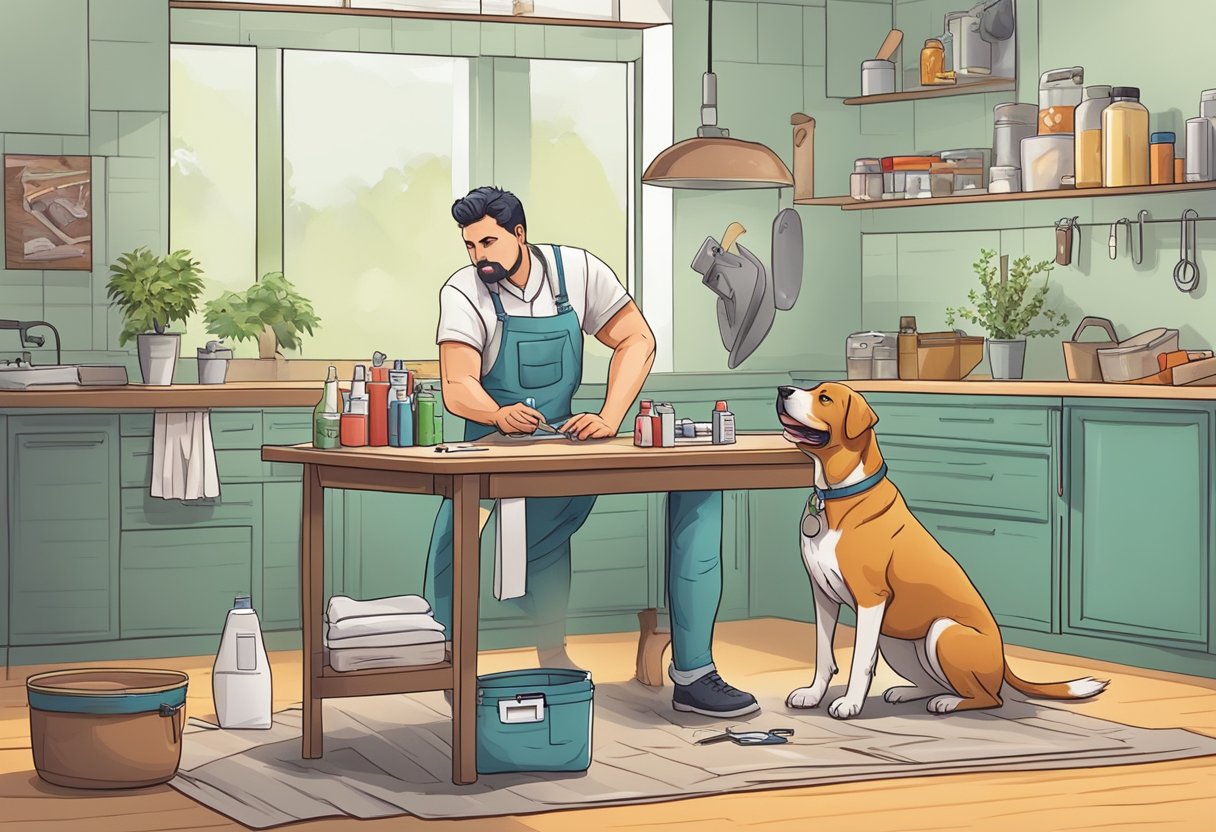
Planning for Future Prevention
Take proactive steps to prevent future accidents:
- Firstly, review the incident documentation and identify any triggers or causes.
- Then, update your safety protocols accordingly.
- Moreover, consider implementing new grooming practices or additional staff training.
Regularly revising your safety measures can significantly reduce the risk of similar incidents.
Wrapping It Up
Frequently Asked Questions
How can you identify a competent and safe dog groomer?
To ensure a safe grooming experience, look for a groomer with certification and positive reviews. They should also provide a clear outline of their safety protocols and be willing to tour you through their facilities.
What steps should you take if your dog has been cut during grooming?
If your dog sustains a cut, initially, apply direct pressure to stop bleeding and consult a vet if the wound seems significant. Additionally, It’s essential to clean the injury with a saline solution and monitor it for signs of infection.
Is legal action possible if a dog is injured or improperly groomed by a professional?
Yes, legal action is possible in case of negligence or harm caused to your dog. It is advisable to document the incident, gather evidence, and consult with a lawyer experienced in animal law.
How can you help your dog recover from grooming-related stress or ‘shave shock’?
Provide a calm environment for your dog to recover from stress or shock post-grooming. Also, offer comfort through gentle petting and a warm blanket and ensure they stay hydrated.
What are the best practices for providing first aid to a dog after a grooming mishap?
For minor injuries, clean the wound with disinfectant, then apply an antibacterial cream or spray. For serious incidents, such as deep cuts or chemical exposure, seek immediate veterinary assistance.
What precautions can be taken to prevent grooming accidents at home or with a professional?
At home, use appropriate and well-maintained tools, and keep your pet stable and calm during grooming. When selecting a professional, ensure they have a good track record and transparent safety measures in place.
Learn More About Dog Care!
Discover gadgets like this that simplify your life with dogs. Find tools for easier, more enjoyable pet care. Unlock essential dog care tips with us. Join our Facebook, Instagram, and Twitter for practical advice, real stories, and a community focused on better dog care.
Facebook: https://www.facebook.com/1LWMD/
Instagram: http://instagram.com/lifewithmydogs2
Twitter : https://twitter.com/LifeWithMyDogs9
Learn more tips about dog care and more with us – where every dog’s health is a priority.
